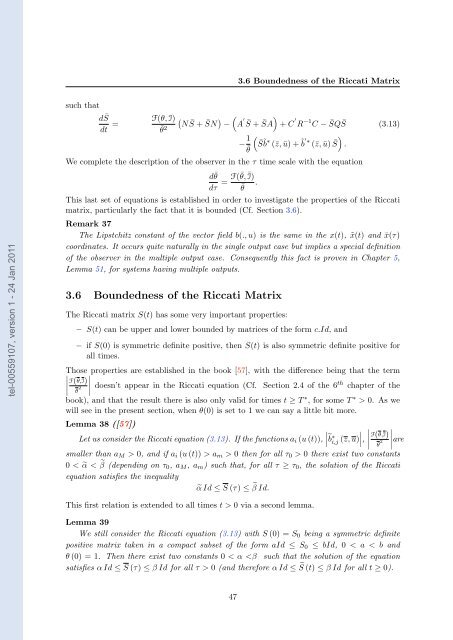Adaptative high-gain extended Kalman filter and applications
Adaptative high-gain extended Kalman filter and applications
Adaptative high-gain extended Kalman filter and applications
You also want an ePaper? Increase the reach of your titles
YUMPU automatically turns print PDFs into web optimized ePapers that Google loves.
tel-00559107, version 1 - 24 Jan 2011<br />
such that<br />
d ¯ S<br />
dt =<br />
F(θ, I)<br />
¯θ 2<br />
� � �<br />
NS ¯ + SN ¯ − A ′ �<br />
S ¯ + SA ¯<br />
3.6 Boundedness of the Riccati Matrix<br />
− 1<br />
¯θ<br />
+ C ′<br />
R −1 C − ¯ SQ¯ S (3.13)<br />
�<br />
.<br />
� ¯S ˜ b ∗ (¯z,ū)+ ˜ b ′ ∗ (¯z,ū) ¯ S<br />
We complete the description of the observer in the τ time scale with the equation<br />
d¯ θ<br />
dτ = F(¯ θ, Ī)<br />
¯θ<br />
.<br />
This last set of equations is established in order to investigate the properties of the Riccati<br />
matrix, particularly the fact that it is bounded (Cf. Section 3.6).<br />
Remark 37<br />
The Lipstchitz constant of the vector field b(., u) is the same in the x(t), ˜x(t) <strong>and</strong> ¯x(τ)<br />
coordinates. It occurs quite naturally in the single output case but implies a special definition<br />
of the observer in the multiple output case. Consequently this fact is proven in Chapter 5,<br />
Lemma 51, for systems having multiple outputs.<br />
3.6 Boundedness of the Riccati Matrix<br />
The Riccati matrix S(t) has some very important properties:<br />
− S(t) can be upper <strong>and</strong> lower bounded by matrices of the form c.Id, <strong>and</strong><br />
− if S(0) is symmetric definite positive, then S(t) is also symmetric definite positive for<br />
all times.<br />
Those � properties are established in the book [57], with the difference being that the term<br />
�<br />
�<br />
� F(θ,I)<br />
�<br />
�<br />
�<br />
� doesn’t appear in the Riccati equation (Cf. Section 2.4 of the 6th chapter of the<br />
θ 2<br />
book), <strong>and</strong> that the result there is also only valid for times t ≥ T ∗ , for some T ∗ > 0. As we<br />
will see in the present section, when θ(0) is set to 1 we can say a little bit more.<br />
Lemma 38 ([57])<br />
�<br />
�<br />
Let us consider the Riccati equation (3.13). If the functions ai (u (t)), ��b ∗ i,j (z,u)<br />
� �<br />
� �<br />
�, �<br />
� F(θ,I)<br />
θ 2<br />
�<br />
�<br />
�<br />
�are smaller than aM > 0, <strong>and</strong> if ai (u (t)) >am > 0 then for all τ0 > 0 there exist two constants<br />
0 < �α < � β (depending on τ0, aM, am) such that, for all τ ≥ τ0, the solution of the Riccati<br />
equation satisfies the inequality<br />
�α Id ≤ S (τ) ≤ � β Id.<br />
This first relation is <strong>extended</strong> to all times t>0 via a second lemma.<br />
Lemma 39<br />
We still consider the Riccati equation (3.13) with S (0) = S0 being a symmetric definite<br />
positive matrix taken in a compact subset of the form aId ≤ S0 ≤ bId, 0 < a < b <strong>and</strong><br />
θ (0) = 1. Then there exist two constants 0 < α 0 (<strong>and</strong> therefore α Id ≤ � S (t) ≤ β Id for all t ≥ 0).<br />
47

















